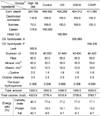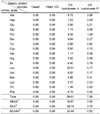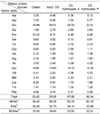1. Anderson JW, Johnstone BM, Cook-Newell ME. Meta-analysis of the effects of soy protein intake on serum lipid. N Engl J Med. 1995. 333:276–282.

2. AOAC. AOAC. Official Methods of Analysis. 1990. 15th ed. Arlington, Va. USA: AOAC International;840–850.
3. Aoyama T, Fukui K, Nakamori T, Hashimoto Y, Yamamoto T, Takamatsu K, Sugano M. Effect of soy and milk whey protein isolates and their hydrolysates on weight reduction in genetically obese mice. Biosci Biotechnol Biochem. 2000a. 64:2594–2600.

4. Aoyama T, Fukui K, Takamatsu K, Hashimoto Y, Yamamoto T. Soy protein isolate and its hydrolysate reduce body fat of dietary obese rats and genetically obese mice (yellow KK). Nutrition. 2000b. 16:349–354.

5. Bieber LL, Markwell M. Peroximal and microsomal carnitine acetyltransferase. Methods in Enzymology. 1981. 71:351–358.
6. Bligh EG, Dyer WJ. A rapid method of total lipids extraction and purification. Can J Biochem Physiol. 1959. 37:911–917.
7. Boirie Y, Dangin M, Gachon P, Vasson MP, Maubois JL, Beaufrere B. Slow and fast dietary proteins differently modulate postprandial protein accretion. Proc Natl Acad Sci U S A. 1997. 94:14930–14935.

8. Boza JJ, Moennoz D, Vuichoud J, Jarret AR, Gaudard-de-Weck D, Ballevre O. Protein hydrolysate vs free amino acid-based diets on the nutritional recovery on the starved rat. Eur J Nutr. 2000. 39:237–243.

9. Canolty NL, Miller PS, Lewis AJ, Wolverton CK, Stroup WW. Changes in plasma urea concentration can be used to determine protein requirements of two populations of pigs with different protein accretion rates. J Anim Sci. 1995. 73:2631–2639.

10. Committee on Animal Nutrition, Board on Agriculture, National Research Council. Nutrient requirements of laboratory animals. 1995. 4th ed. Washington DC. USA: National Academy Press.
11. Cota D, Proulx K, Blake Smith KA, Kozma SC, Thomas G. Hypothalamic mTOR signaling regulates food intake. Science. 2006. 312:927–930.

12. Daenzer M, Petake KJ, Bequette BJ, Metges CC. Whole-body nitrogen and splanchnic amino acid metabolism differ in rats fed mixed diets containing casein or its corresponding amino acid mixture. J Nutr. 2001. 131:1965–1972.

13. David LN, Michael MC. Lehninger principles of biochemistry. 2004. 4th ed. New York. USA: Worth Publishers.
14. Frank BH. Protein, body weight, and cardiovascular health. Am J Clin Nutr. 2005. 82:242S–247S.
15. Frings CS, Dunn RT. A colorimetric method for determination of total serum lipid based on the sulfuric-phosphovanillin reaction. Am J Clin Nutr. 1970. 53:89–90.
16. Garlick PJ. The role of leucine in the regulation of protein metabolism. J Nutr. 2005. 135:1553S–1556S.

17. Geer BW, Krochko D, Oliver MJ, Walker VK, Williamson JH. A comparative study of the NADP-malic enzymes from Drosophila and chick liver. Comp Biochem Physiol. 1980. 65B:25–34.

18. Gutierrez MA, Mitsuya T, Hatta H, Koketsu M, Kobayashi R, Juneja LR, Kim M. Comparison of egg-yolk protein hydrolysate and soyabean protein hydrolysate in terms of nitrogen utilization. Br J Nutr. 1998. 80:477–484.

19. Héliès JM, Diane A, Langlois A, Larue-Achagiotis C, Fromentin G, Tomé D, Mormede P, Marissal-Arvy N. Comparison of fat storage between Fischer 344 and obesity-resistant Lou/C rats fed different diets. Obes Res. 2005. 13:3–10.

20. Horiguchi N, Horiguchi H, Suzuki Y. Effect of wheat gluten hydrolysate on the immune system in healthy human subjects. Biosci Biotechnol Biochem. 2005. 69:2445–2449.

21. Hwang EH, Kang BG, Kim BR, Lee HJ. Protein quality evaluation and effect of plasma lipid contents of acid hydrolysates of cocoon in rats fed by high cholesterol, high triglyceride and high sucrose diet. Journal of the Korean Society of Food Science Nutrition. 2001. 30:1004–1009.
22. Iritani N, Hosomi H, Fukuda H, Tada K, Ikeda H. Soybean protein suppresses hepatic lipogenic enzyme gene expression in Wistar fatty rats. J Nutr. 1996. 126:380–388.

23. Iritani N, Nagashima K, Fukuda H, Katsurada A, Tanaka T. Effects of dietary proteins on lipogenic enzymes in rat liver. J Nutr. 1986. 116:190–197.

24. Ishihara K, Fukuchi Y, Mizunoya W, Mita Y, Fukuya Y, Fushiki T, Yasumoto K. Amino acid composition of soybean protein increased postprandial carbohydrate oxidation in diabetic mice. Biosci Biotechnol Biochem. 2003. 67:2505–2511.

25. Kagawa K, Matshtaka H, Fukuhama C, Fujino H, Okuda H. Suppressive effect of globin digest on postprandial hyperlipidemia in male volunteers. J Nutr. 1998. 128:56–60.

26. Kim DM, Ahn CW, Nam SY. Prevalence of obesity in Korea. Obes Rev. 2005. 6:117–121.

27. Layman DK. The role of leucine in weight loss diets and glucose homeostasis. J Nutr. 2003. 133:261S–267S.

28. Layman DK, Walker DA. Potential importance of leucine in treatment of obesity and the metabolic syndrome. J Nutr. 2006. 136:319S–323S.

29. Lee HJ, Kim WL, Kim KH, Kim HK, Lee HJ. Antitumor activity of peptide fraction from traditional Korean soy sauce. J Microbiol Biotechnol. 2004. 14:628–630.
30. Lee HM, Chang UJ. Effect of corn peptide on the lipid metabolism in rats. Korean Journal of Dietary Culture. 2001. 16:416–422.
31. Lee YS, Shin MK, Lee YD, Lee HS. Enhanced effects of gluten hydrolysate on solubility and bioavailability of calcium in rats. The Korean Journal of Nutrition. 1997. 30:40–47.
32. Lu XX, Chen XH, Tang JZ. Studies on the functional property of enzymatic modified corn protein. Food Science. 2000. 21:13–15.
33. Markwell M, McGroarty EJ, Bieber LL, Tolbert NE. The subcellular distribution of carnitine acyltransferases in mammalian liver and kidney. J Biol Chem. 1973. 248:3426–3432.

34. Metges CC, EI-Khoury AE, Selvaraj AB, Tsay RH, Atkinson A, Regan MM, Beguette BJ, Young VR. Kinetics of L-[1-(13)C] leucine when ingested with free amino acids, unlabeled or intrinsically labeled casein. Am J Physiol Endocrinol Metab. 2000. 278:E1000–E1009.
35. Miyoshi S, Ishikawa H, Kaneko T, Fukui F, Tanaka H, Maruyama S. Structures and activity of angiotensin-converting enzyme inhibitors in an α-zein hydrolysate. Agric Biol Chem. 1990. 55:1313–1318.

36. Moriyama T, Kishimoto K, Nagai K, Urade R, Ogawa T, Utsumi S, Maruyama N, Maebuchi M. Soybean beta-conglycinin diet suppresses serum triglyceride levels in normal and genetically obese mice by induction of beta-oxidation, downregulation of fatty acid synthase, and inhibition of triglyceride absorption. Biosci Biotechnol Biochem. 2004. 68:352–359.

37. Motoi H, Kodama T. Isolation and characterization of angiotensin I-converting enzyme inhibitory peptides from wheat gliadin hydrolysate. Nahrung. 2003. 47:354–358.

38. Nagata Y, Ishiwaki N, Sugano M. Studies on the mechanism of antihypercholesterolemic action of soy protein and soy protein-type amino acid mixtures in relation to the casein counterparts in rats. J Nutr. 1982. 112:1614–1625.

39. Nepokroeff CM, Lakshmanan MR, Porter JW. Fatty acid synthase from rat liver. Methods in Enzymology. 1975. 35:37–44.
40. Noltmann EA, Gubler CJ, Kuby SA. Glucose-6-phosphate dehydrogenase (Zwischenferment). I. Isolation of the crystalline enzyme from yeast. J Biol Chem. 1961. 236:1225–1230.
41. Reeves PG, Nielsen FH, Fahey GC. AIN-93 purified diets for laboratory rodents: Final report of the American Institute of Nutrition Ad Hoc writing committee on the reformulation of the AIN-76A rodent diet. J Nutr. 1993. 123:1939–1951.

42. Suh HJ, Whang JH, Suh DB, Bae SH, Noh DO. Preparation of angiotensin I converting enzyme inhibitory from corn gluten. Process Biochem. 2003. 38:1239–1244.

44. Woods SC, Seeley RJ, Rushing PA, D'Alessio D, Tso P. A controlled high-fat diet induces on obese syndrome in rats. J Nutr. 2003. 133:1081–1087.
45. Yamaguchi M, Nishikiori F, Ito M, Furukawa Y. Effect of corn peptide on alcohol metabolism and plasma free amino acid concentrations in healthy men. Eur J Clin Nutr. 1996a. 50:682–688.
46. Yamaguchi M, Takada M, Nozaki O, Ito M, Furukawa Y. Preparation of corn peptide from corn gluten meal and its administration effect on alcohol metabolism in stroke-prone spontaneously hypertensive rats. J Nutr Sci Vitaminol. 1996b. 42:219–231.

47. Yang Y, Tao G, Liu P, Liu J. Peptide with Angiotensin I-Converting Enzyme Inhibitory Activity from Hydrolyzed Corn Gluten Meal. J Agric Food Chem. 2007. 55:7891–7895.

48. Zheng XQ, Li LT, Liu XL, Wang XJ, Lin J, Li D. Production of hydrolysate with antioxidative activity by enzymatic hydrolysis of extruded corn gluten. Appl Microbiol Biotechnol. 2006. 73:763–770.














 PDF
PDF ePub
ePub Citation
Citation Print
Print



 XML Download
XML Download